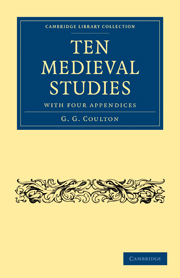Book contents
- Frontmatter
- PREFACE TO FIRST EDITION (1906)
- PREFACE TO SECOND EDITION (1915)
- PREFACE TO THIRD EDITION
- Contents
- I The Monastic Legend
- II A Revivalist of Six Centuries Ago
- III Side-Lights on the Franciscans
- IV The High Ancestry of Puritanism
- V Romanism and Morals
- VI The Truth about the Monasteries
- VII Religious Education before the Reformation
- VIII Priests and People before the Reformation
- IX The Failure of the Friars
- XIII The Plain Man's Religion in the Middle Ages
- Appendices
- Index
II - A Revivalist of Six Centuries Ago
Published online by Cambridge University Press: 07 September 2010
- Frontmatter
- PREFACE TO FIRST EDITION (1906)
- PREFACE TO SECOND EDITION (1915)
- PREFACE TO THIRD EDITION
- Contents
- I The Monastic Legend
- II A Revivalist of Six Centuries Ago
- III Side-Lights on the Franciscans
- IV The High Ancestry of Puritanism
- V Romanism and Morals
- VI The Truth about the Monasteries
- VII Religious Education before the Reformation
- VIII Priests and People before the Reformation
- IX The Failure of the Friars
- XIII The Plain Man's Religion in the Middle Ages
- Appendices
- Index
Summary
There is a charming essay on Religious Revivals in Medieval Italy among the old Cornhill essays of the late J. A. Symonds. He describes in the first place the “Great Alleluia” of 1233, and the marvellous career of John of Vicenza, under whose influence north Italy seemed for a few weeks to have no business but prayer and praise and religious processions. John and his companion friars healed for a time the most inveterate feuds: city after city surrendered to them at discretion, and allowed its statutes to be made or unmade by these wandering preachers. Vivid as is Symonds's description of the Revival, he yet leaves some of the most curious details ungleaned. The Statutes of Parma, for instance, show us the friars cleansing that great cathedral of the corn which, to the scandal of the more devout, was habitually stored in its nave—just as, in the year after Dante's great vision, a Devonshire parson was found using his church as granary and brew-house combined. Again, the Franciscan Salimbene gives us many curious details of the Great Alleluia, which probably determined his own conversion. Sincere believer as he is, he nevertheless describes with great gusto the ingenious bogus miracles which his great friend Brother Gerard of Modena used to concoct in conjunction with John of Vicenza; and he assures us that many were converted by this means. He also describes how Brother John's head was turned by his success. When the great preacher was shaved during a visit to a Franciscan convent he was naively disappointed (it appears) that the Brethren did not pounce on the shavings for relics. Such little touches go to explain John's final fall.
- Type
- Chapter
- Information
- Ten Medieval Studieswith Four Appendices, pp. 30 - 41Publisher: Cambridge University PressPrint publication year: 2010First published in: 1930



